

 The Accurate Reloading Forums
The Accurate Reloading Forums  THE ACCURATE RELOADING.COM FORUMS
THE ACCURATE RELOADING.COM FORUMS  Other Topics
Other Topics  Recipes for Hunters
Recipes for Hunters  My First Attempt at Bacalao al Pil-Pil
My First Attempt at Bacalao al Pil-PilGo  | New  | Find  | Notify  | Tools  | Reply  |  |
| one of us |
My First Attempt at Bacalao al Pil-Pil Salt Cod in Pil-Pil Sauce When I first started collecting books of the Time/Life Foods of the World series, I immediately gravitated to the volume on Spain and Portugal and began reading it eagerly. I found the chapter on Basque cooking particularly interesting, with fascinating photos that drew me right in; it seemed that here was an area and a culture that was truly unique, and that uniqueness contributed to the cuisine. I found it fascinating that certain concepts would be so integral, not only to the land and the people, but to the food as well. From Time/Life's Foods of the World - The Cooking of Spain and Portugal, 1969:
As I continued reading, I was introduced to several facets of the Basque culture that contributed to the well-deserved reputation for excellence that Basque cooks enjoy:
This idea of men getting together for the sole purpose of cooking and enjoying the bounty of the Basque table fascinated me, and it was natural to put myself in the position of a visitor to Basque country:
No study of Basque cuisine would be complete without broaching the subject of seafood, which is so integral to Basque cooking that it would be hard to imagine the cuisine without it. The proximity to the Bay of Biscay and the Atlantic assures that there will always be an abundant bounty from the ocean, ready to be brought to its highest elevation by skilled cooks with a built-in instinct for excellence and innovation:
One of the quintessential seafood dishes on Basque culture is Bacalao al Pil-Pil, which is salt cod cooked in simple and humble fashion with very little frivolity; this dish is the essence of Basque cooking in that the main ingredient is not only the star, but also the instrument of its own embellishment. This concept brings us back to the opening comments regarding pure ingredients, sauces, gravies. Time/Life elaborates:
The careful dance that results in the pil-pil sauce involves gentle heat and motion, emulsifying the natural juices of the cod into the garlic-infused oil that it is cooked in and creating a new ingredient that enhances and highlights its components. To me, it is an example of the fundamental truth that simple ingredients prepared simply will create their own elegance. Interestingly, When I was researching this project, I found that the Guria restaurant in Bilbao, which prepared the bacalao al pil-pil pictured above, is still in existence. With a little bit of digging, I discovered that this quintessential Basque dish is still on their menu, and even found a modern photo showing their preparation of it: 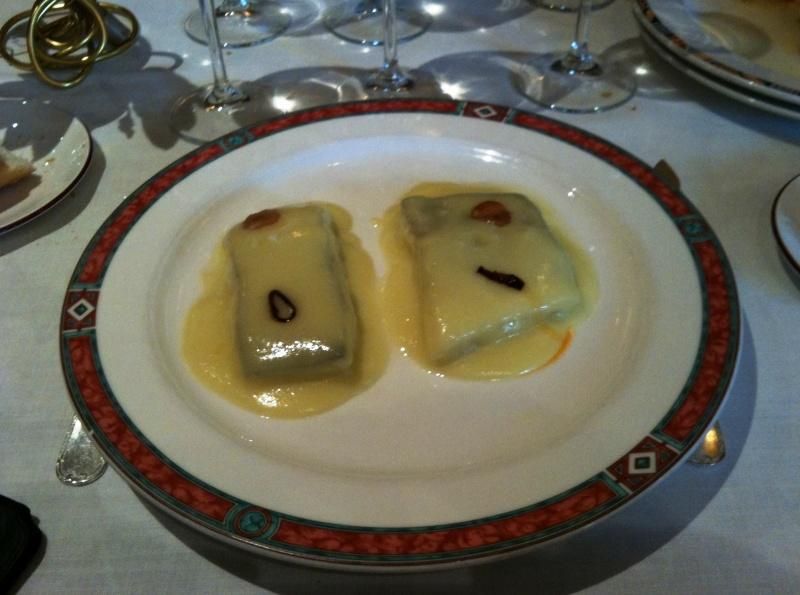 Photo credit: http://1.bp.blogspot.com/-L1AR...HE/s1600/Pil-Pil.JPG Note how the tablecloth design in the old photo is very similar to the rim of the plate in the new photo; it seems that in Basque country, the past and the present are always interwoven into a timeless tapestry. My reading indicates that the dish that we've come to know as bacalao al pil-pil is not quite as it was originally made, although it is very close. According to at least two sources (Kurlansky and Busca Isusi), the original bacalao al pil-pil was prepared in the same tradition that eels were prepared, with gentle, sizzling cooking in olive oil, seasoned with garlic and perhaps a sliced pepper; however, the juices from the fish were not blended with the olive oil into a sauce - it was simply served, the same way that the eels are. It seems this method for cooking cod traces back to around the same time as a Basque uprising known as the Third Carlist War, circa 1830, when an abundance of salt cod procured through a clerical error necessitated innovative methods in cooking it. Eventually, it was discovered that the juices of the cooking cod, when subjected to gentle motion, would emulsify with the oil it was cooking in, resulting in a unique and delicious preparation. To prepare this dish, I chose to use a recipe from Karlos Arguiñano, a renowned Basque chef who is known for his simple, elegant preparations of traditional Basque dishes. Below is my best attempt at a translation of Arguiñano's recipe, garnered from what Google's translation tool provided and supplemented with what I know about the dish as well as what I observed while watching the accompanying video. As you can see, the ingredients for the recipe are so basic - so minimalist - that the pure, unadulterated flavours are allowed to come through and be taken to a level that is bound only by the skill of the one preparing the dish:
When I made this dish for the first time, things did not go entirely as planned. Due to an execution error, the pil-pil sauce did not formulate the way it was supposed to, and in modern, technical terms, I failed in my goal. Having said that, what I ended up preparing was actually very close to the original way that bacalao al pil-pil was prepared, so I am calling it a "successful failure." The important thing, to me, is that the dish tasted excellent, and I had no complaints at all where flavour was concerned; indeed, the Beautiful Mrs. Tas, who is by no means a lover of fish, really enjoyed this dish, and in spite of the almost-prohibitive cost, she is looking forward to the next time I make it. I hope that my next attempt will allow me to achieve the goal of integrating the sauce the way it is intended to be. In any case, here is a record of my first attempt at bacalao al pil-pil.… The primary ingredient, of course, is salt cod. Living where I do, this is extremely difficult to procure; luckily I had the very good fortune to meet a most excellent friend a few years ago - you know him here as "Hoser," but I like to call him "Dave!" Anyway, since Dave lives near a bustling and thriving Portuguese community on the East Coast, he is able to come across a few things that are not easy to get around here, and he graciously sent a supply of salt cod to me: 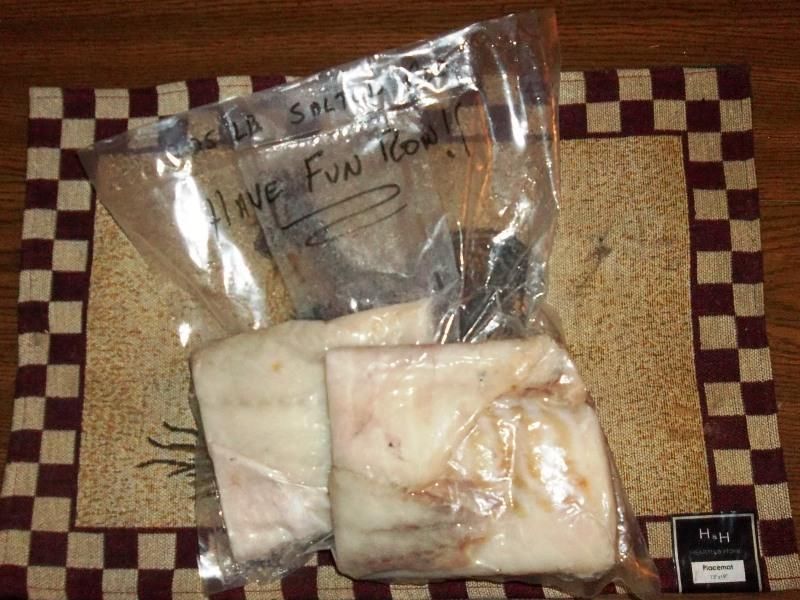 This salt cod came from A J Seabra, a chain of Portuguese supermarkets based in New Jersey, and was some really fine-quality stuff; it smelled fresh and ultimately had a wonderful flavour that seemed to be more than the sum of its components - a truly special treat that I will always remember fondly. Dave also penned some advice:  This admonition set a perfect tone for this project, and I must say that I had a great time with it ~ Thank you, Dave! Salt cod is made by packing the cod fillets in sea salt, which preserves the fish via partial dehydration, creating a dry, salty environment where food-borne pathogens cannot grow. This is a very, very old method for preserving cod and other fish, and during the days before refrigeration, it allowed the humble codfish to create a huge amount of commerce as it fed much of the known world. Salt cod is not so common in these days of flash-frozen packaging, but it is still sought out as the preferred way to prepare many dishes, including this one. In order to use salt cod in a dish, the excess salt must be soaked out. This has a secondary effect of "re-hydrating" the fillets, causing them to expand back to their original size, as well. There's nothing complicated about this process, simply submerge the fillets in an appropriate amount of fresh water: 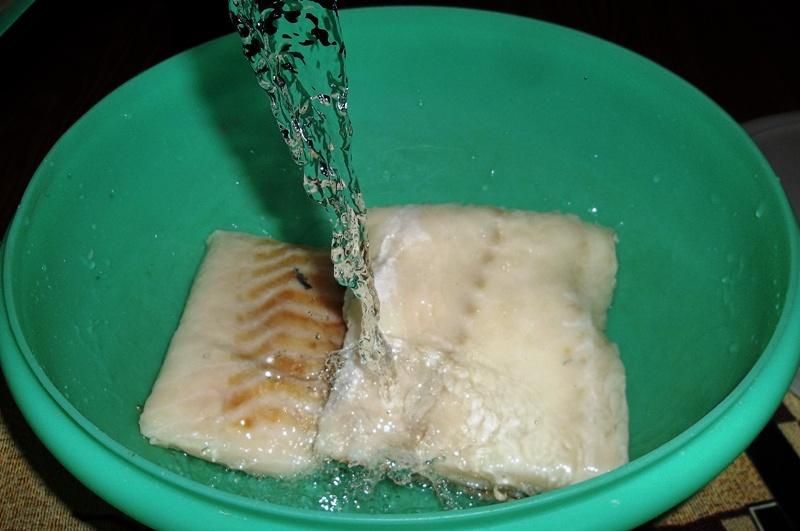 Once this was done, I covered the bowl: 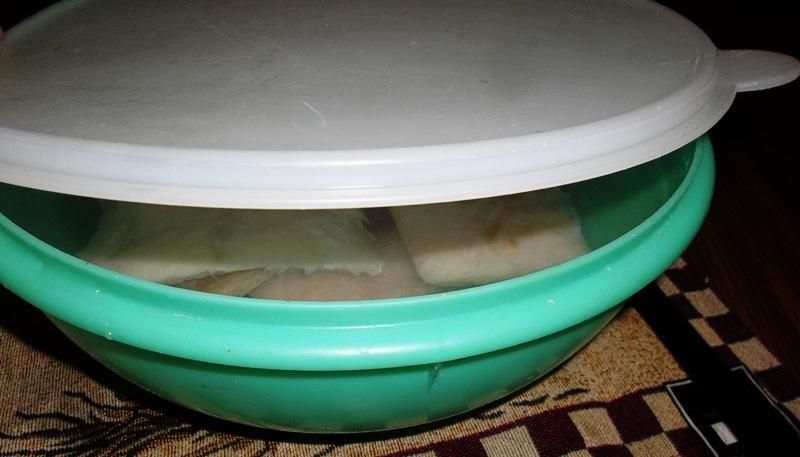 And placed it in the refrigerator. Over the course of the next 48 hours, I changed the water every 8 hours or so, until the water was no longer salty and I was ready to begin this dish. One of the main things I love about this dish is how it is so quintessentially Basque in nature: it is simple, with few ingredients that are utilised to their maximum potential. Here's all you need: 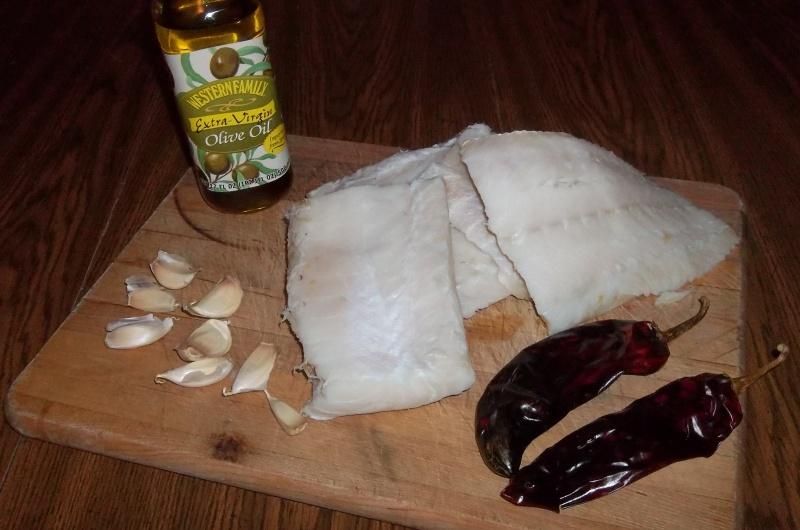 Olive oil (in this case, imported from Spain), garlic cloves, the de-salinated cod fillets and a couple of dried, red chiles. A note about the chiles: Watching the video, I noticed that a long, triangular, dried red pepper is used, cut into strips, sautéed in olive oil to infuse some flavour, and then employed as a garnish for the finished dish. The chiles used in the video are evidently traditional dried espelette peppers, which are of course unavailable here and, even if available, would probably be too hot for the Beautiful Mrs. Tas - because of this, I set about looking for an acceptable substitute that would be more suited for our available resources and her preferences, without changing the dish too much. Based on what I was able to learn, and considering the availability of what I could find, I ultimately selected dried New Mexico chiles; they are dark red (the right colour), they are relatively mild, they are the right shape and - most importantly - they are available! They turned out to be a very good, flavourful choice, and I recommend them to anyone looking for a good substitute. In any case, let's get started! First, I gently crushed and peeled the garlic cloves: 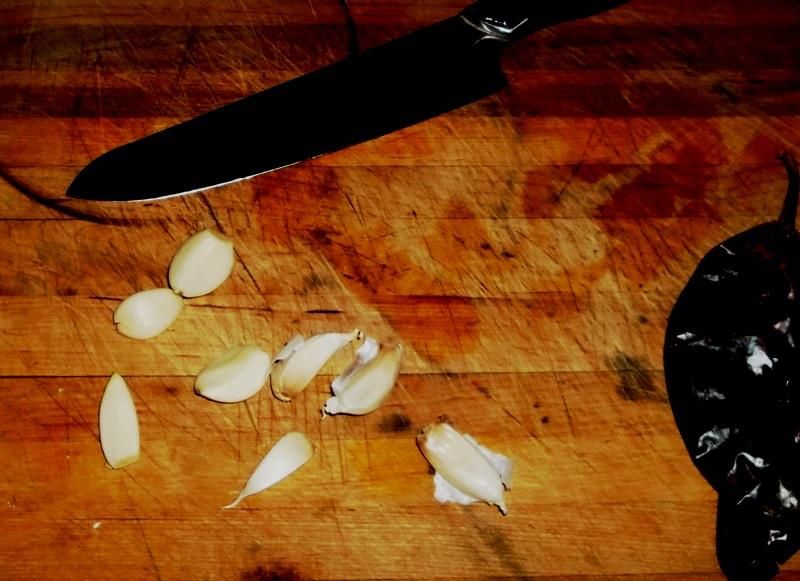 Sometimes, the garlic cloves are sliced longitudinally into "chips," but I elected to keep them whole this time, for simplicity's sake. Next, I sliced the chiles into strips: 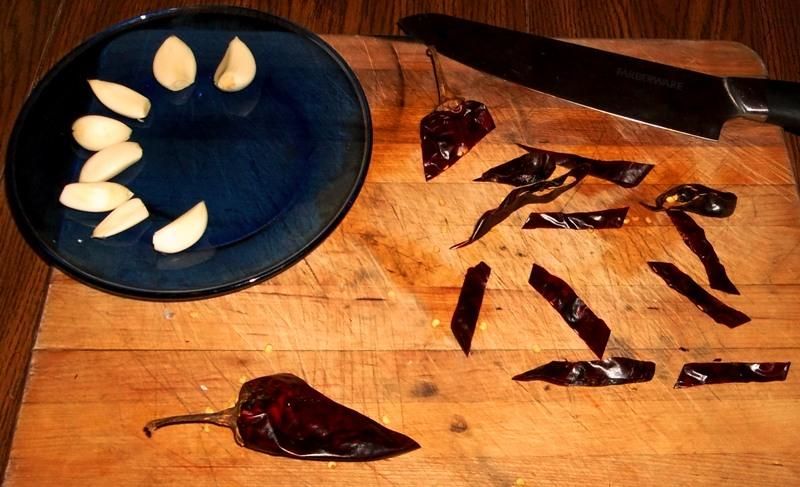 Then, I trimmed the cod fillets into uniform portions: 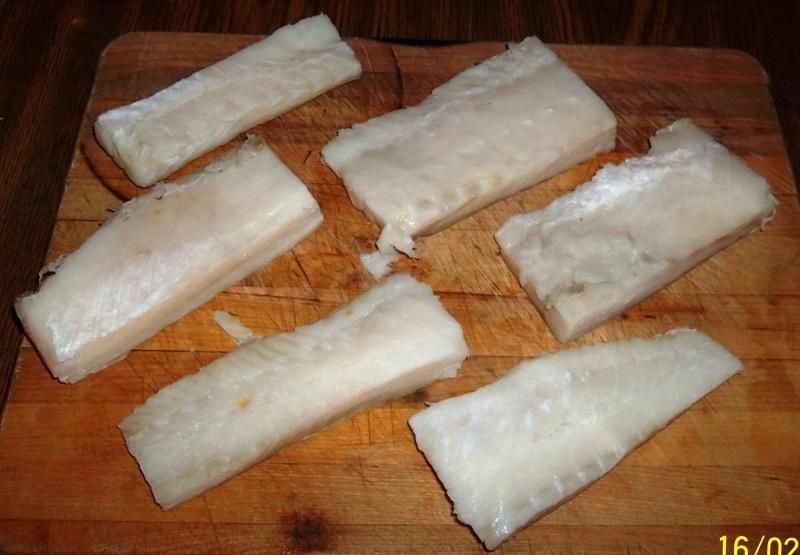 There were a few trimmings, bits and pieces that I reserved, intending to use them for other projects or perhaps a as a base for some fish stock. Here we are with the few but oh so essential ingredients, ready to begin cooking: 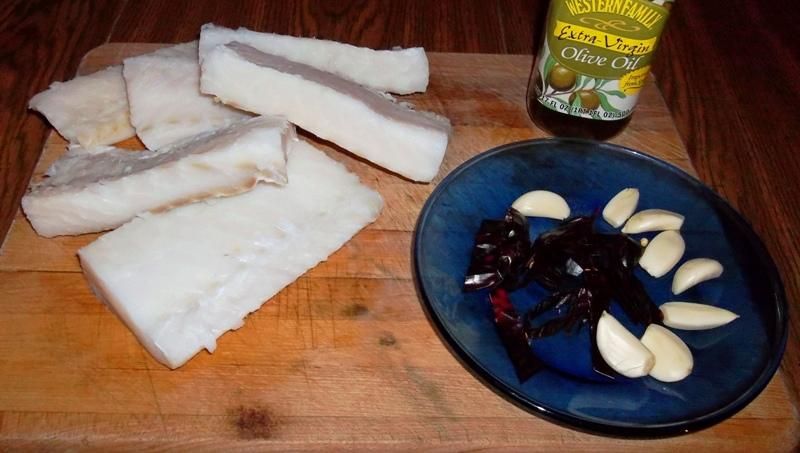 The only other ingredient that one might choose to employ would be parsley, as a garnish and for colour; however, in my town, there is no finding fresh parsley on a weekend, so I went without. Aside from those few ingredients, there are of course some cookware and utensils that come in handy when making this dish; first and foremost is a glased, terra cotta cazuela:  This dish can surely be prepared most adequately with a stainless steel or other appropriate sauté pan; however, I figured that if I was going to do this, I might as well jump in and do it right, so I purchased a 12.8-inch (32.5-cm) cazuela from La Tienda: www.latienda.com. It was definitely a good purchase, and I am looking forward to using it for many Iberian and other projects. In addition, there are a few other things that might prove helpful:  A plate to hold the garlic and dried chile strips once they are sautéed, a deep, wide platter to hold the cooked cod fillets and collect their juices, a small sieve, to begin the process of emulsifying the pil-pil sauce, and a wire whisk to use once the sauce enters a state where it is fairly stable. To begin, I heated the olive oil to a medium and dropped in the garlic cloves, in order to infuse the garlic flavour into the oil and take on a slight toasted colour: 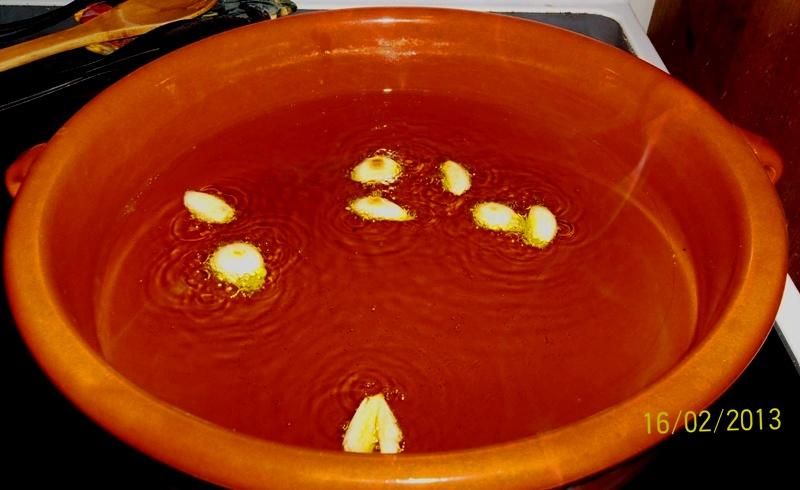 When the garlic cloves just started to take on colour, I dropped in the strips of dried chiles for just a few moments, to also flavour the oil: 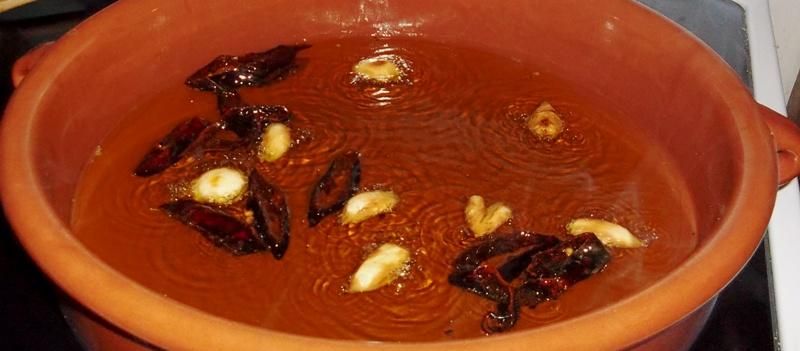 At this point, I also reduced the heat to low - or, at least I thought I did. After removing the garlic cloves and strips of dried chiles, I waited a few minutes for the temperature of the oil to drop, then added the cod fillets: 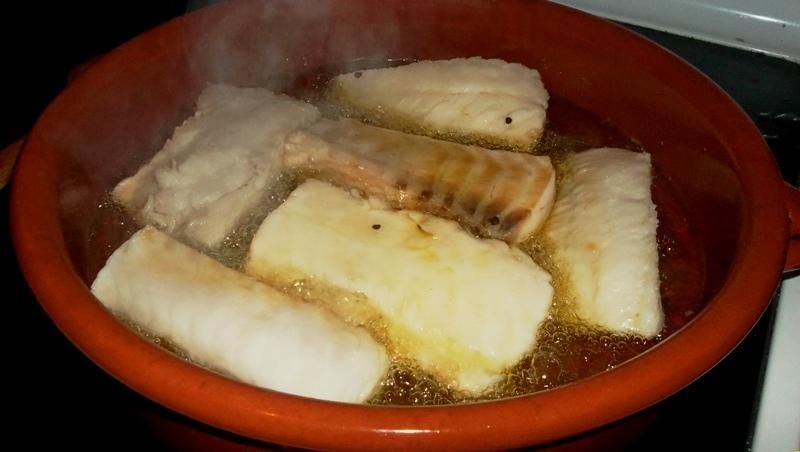 In Karlos's video, he does not seem very concerned about crowding the pan, so I put all of the fillets in, relying on the cazuela's outstanding heat retention properties to keep the oil from cooling too much. After 4 minutes, I turned the fillets: 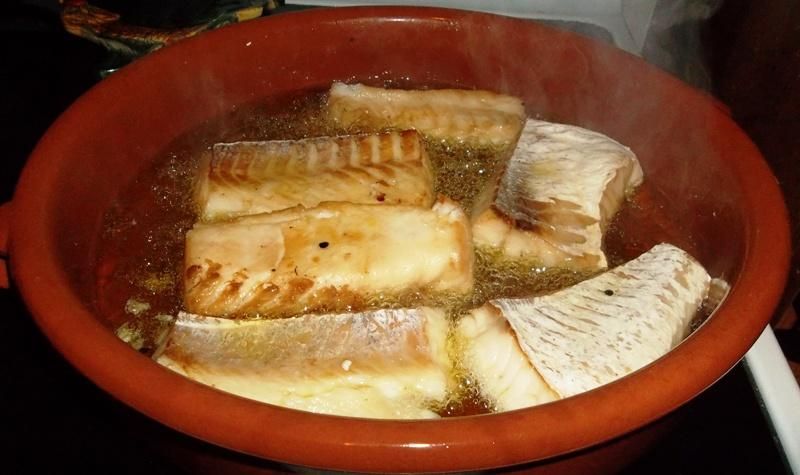 It was here that I noticed that the heat still seemed a little high, but since the knob on the stove indicated the lowest setting, I didn't think too much of it and assumed that the oil would continue cooling. What I didn't know at the time is that somehow the heat setting had not been reduced at all, and I was still cooking at full-on medium, which is much too hot for this dish at this stage. When the cod fillets had cooked another 3 or 4 minutes on the second side, I removed them to the platter so that they could rest: 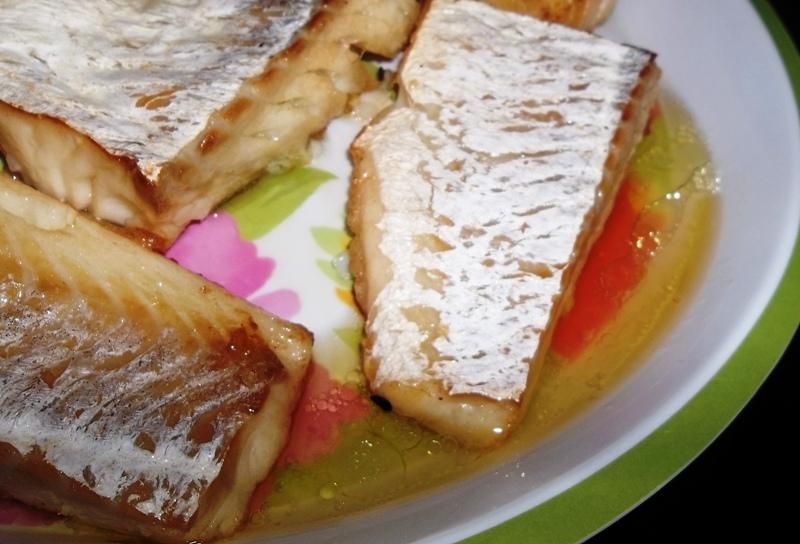 It is during this time that they should release their serum or juices, which will later be emulsified into the oil to form the pil-pil sauce; however, due to the high heat, most of the juices had been forced out into the cazuela and were cooked to the point where they were unable to be emulsified. It was at this point that I noticed my error, and immediately turned the knob of the stove to off so that the cazuela could cool down and hopefully salvage the project, but unfortunately the damage had been done. Being the persistent person that I am, I tried to form the sauce anyway, turning the stove back on to the lowest setting (which worked fine this time) and whisking back and forth with the sieve: 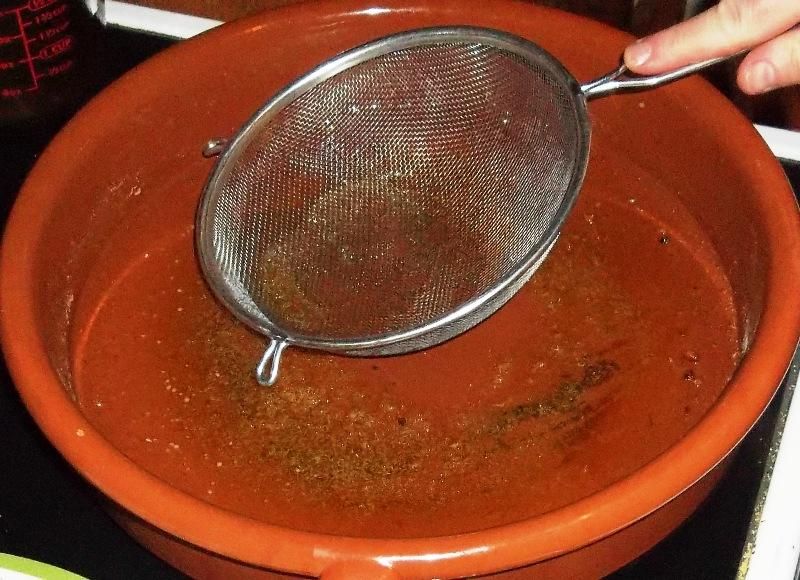 This had very little to no effect, as you can see, because the essential juices were cooked. I added the juices that had drained off the fish into the platter, but it wasn't enough to kick-start the process. In my desperation, I added the few pieces of salt cod that resulted when I trimmed the fillets, hoping that they would release enough serum to form the sauce: 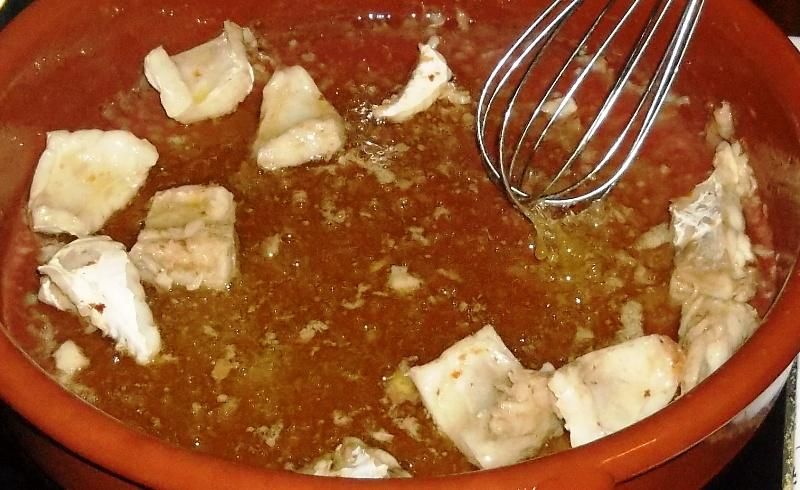 As you can see, it kept looking as though the process would start, but it never was able to sustain itself and form the sauce in the way that modern preparations do. Be that as it may, I did have an excellent meal here, cooked very much in the way that the original bacalao al pil-pil had been prepared, so I returned the cod fillets to the cazuela in order to heat up a bit: 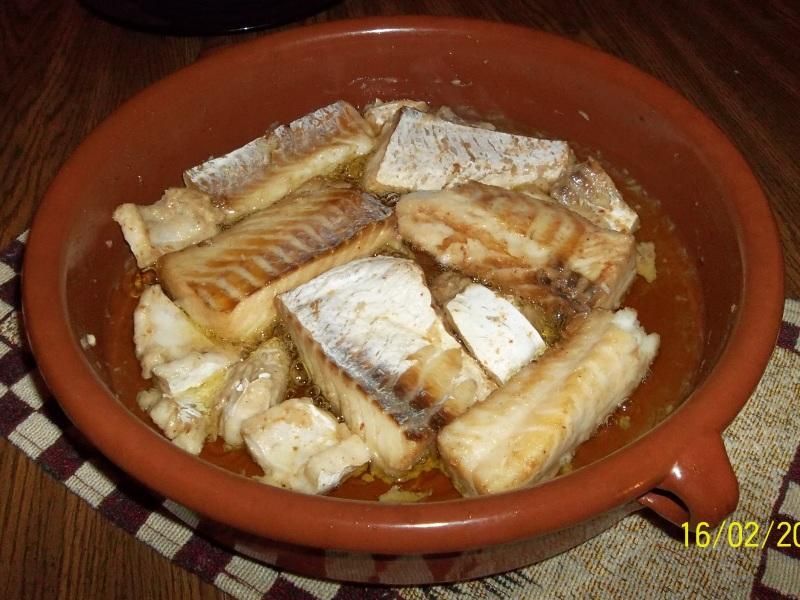 And then served my meal: 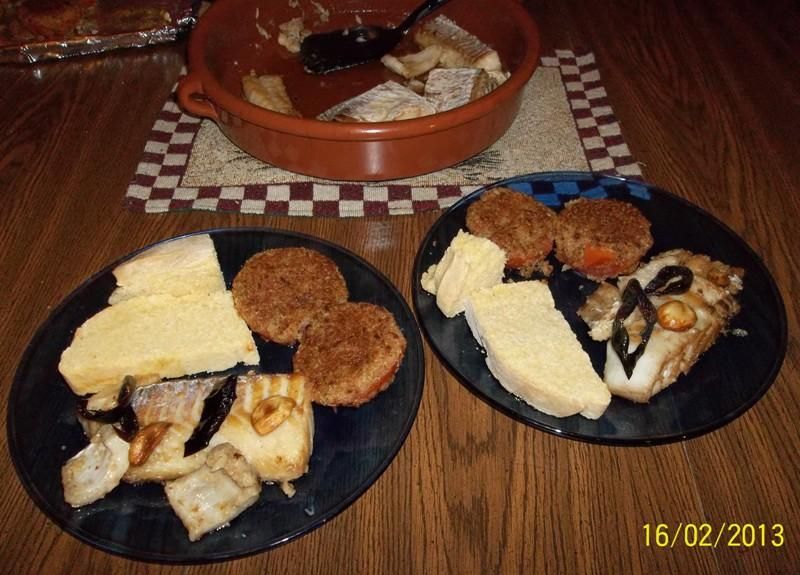 Aside from the lack of emulsified pil-pil sauce, the dish was quite a success, and tasted excellent. 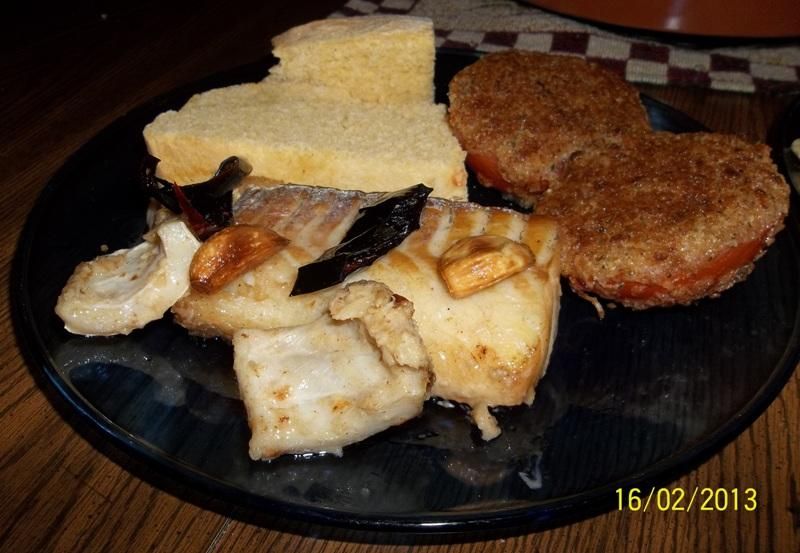 I had never had salt cod in any form before this, and was impressed with the way it picked up the flavours of the other ingredients: the olive oil, the toasted garlic and the fruity, slightly-spicy chiles. 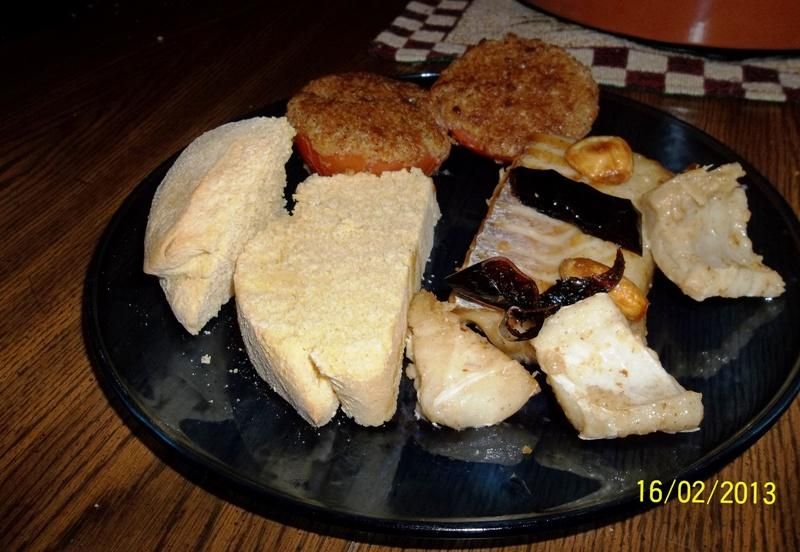 There was just a hint of salt flavour, to provide a nice, savory base, and the fish was firm and flaky in texture - probably just slightly over-cooked, but nonetheless delicious. When choosing a bread to bake for this meal, I wanted something that would be Iberian in nature; something that would be plausible in Basque country and go well with a fish meal. Finally, I wanted to pay tribute to my friend Dave, and the Portuguese market where his gift came from. It wasn't long before I found the perfect choice, Portuguese corn bread: 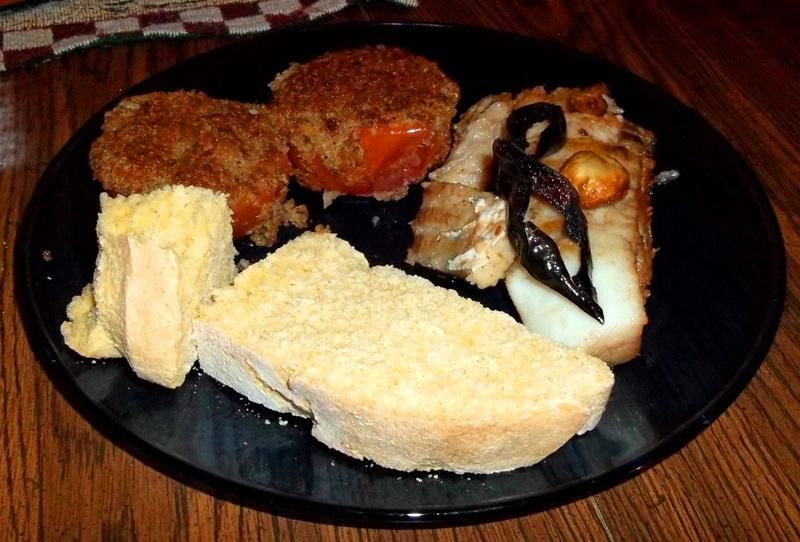 Corn is an important crop in Basque country, and fresh-baked breads are a fixture at nearly any meal. The corn bread was absolutely a great choice for this dish, and was enjoyed by all. Here's a link to a step-by-step pictorial on Portuguese cornbread, if you are interested: http://foodsoftheworld.activeb...milho_topic3361.html For a side dish, I chose to try an idea that I got from Chris: broiled tomatoes topped with a butter-and-herb bread crumb mixture and a hint of Parmesan cheese: 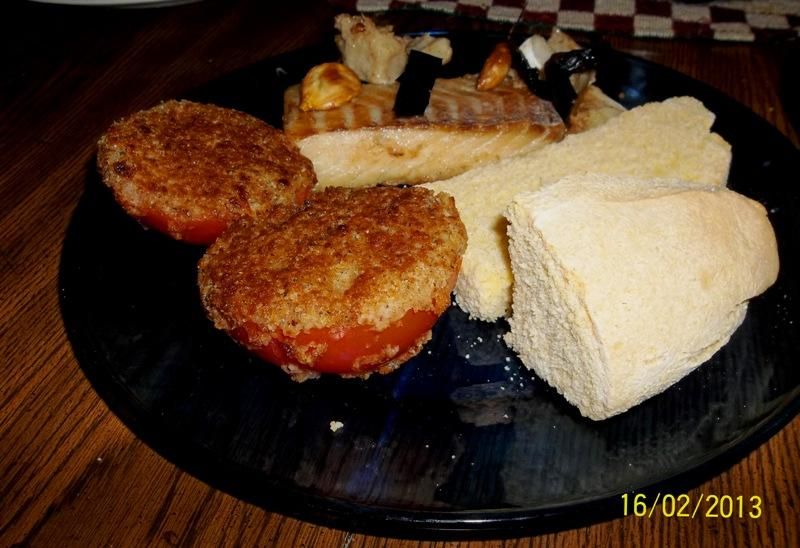 These were delightfully simple to make and bursting with wonderful flavours; the only real problem is that I used store-bought bread crumbs that seemed, to me, to be excessively fine and dry. In the future, I will make my own bread crumbs, which will hopefully provide a better texture. Having said that, the flavours of this simple tomato side dish were wonderful, and perfectly at home on a Basque plate, I think. Over-all, this was an outstanding meal, in spite of a couple of minor execution errors, and provided a wonderful introduction to the Basque traditions of cooking seafood. I will - most definitely - be preparing this again, as soon as I can get my hands on some more salt cod.  Thanks for taking the time to read this - I hope you enjoyed the experience as much as I did. If anyone wants to try this, please feel free to ask any questions, and I will get some answers for you. As you can see from reading this report, one primary rule must be to keep your heat low; trust your cookware to do the cooking for you, and pay careful attention to procedure and detail. If you do this, there is no reason why you can't enjoy success on your first attempt; however, even if it doesn't work out as you plan, chances are that you will still end up with a wonderful and delicious Basque meal. Ron | ||
|
| one of us |
I ate tons of this growing up.If you eat this you will see why the best tasting fish is saltwater fish | |||
|
| one of us |
Bacalao-always served with a mash potato-garlic side plate.Its like fries and ketchup. I will ask and find out how the side plate is made.Beets also compliment this excellent dish. I should post a pic some day! | |||
|
| one of us |
[QUOTE]Originally posted by shootaway: Bacalao-always served with a mash potato-garlic side plate.Its like fries and ketchup. I will ask and find out how the side plate is made.Beets also compliment this excellent dish. I should post a pic some day! | |||
|
| one of us |
To make the mash potato side dish you need to boil some potatoes untill soft.Then use a mixer and some boiling water to mash them up.Add some pressed garlic and blend until smooth.Then add vinegar and olive oil until it taste just right. | |||
|
| one of us |
Hi, Shootaway - Those mashed potatoes sure sound good, and I am willing to bet that they would go perfectly with this dish, with beets supplying some great colour ~ | |||
|
| one of us |
[URL= 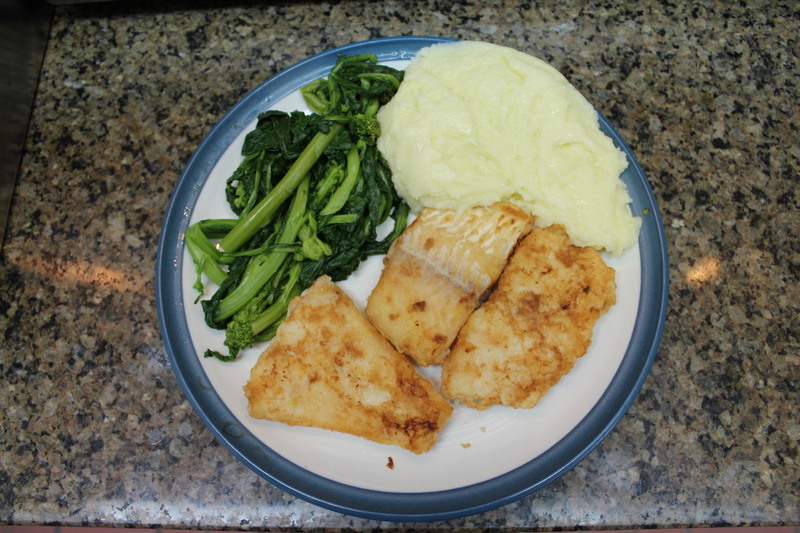 ]bacalao[/URL] ]bacalao[/URL] | |||
|
| one of us |
that looks delicious! | |||
|
| Powered by Social Strata |
| Please Wait. Your request is being processed... |
|
 The Accurate Reloading Forums
The Accurate Reloading Forums  THE ACCURATE RELOADING.COM FORUMS
THE ACCURATE RELOADING.COM FORUMS  Other Topics
Other Topics  Recipes for Hunters
Recipes for Hunters  My First Attempt at Bacalao al Pil-Pil
My First Attempt at Bacalao al Pil-Pil

Visit our on-line store for AR Memorabilia

